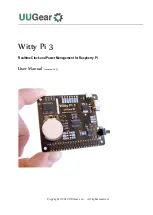
Triggering Readers
Trigger via Photoeye:
l
Port C2 corresponds to C0 input of the reader.
l
Port C3 corresponds to C1 input of the reader.
l
Each port has two different physical inputs that can be used PIN 2 / PIN 4.
l
This selection can be made with “Trigger PIN” bit in “Trigger Control”.
l
The trigger point on PE could be executed either on Leading or Trailing edge of the signal.
l
This selection can be made with “Trigger Edge” bit in “Trigger Control”.
l
There is a “Trigger Settings” bit that allows the two readers to be triggered simultaneously from one PE point from
port C0.
Trigger via Fieldbus:
l
Triggering can be executed from Profinet and Ethernet/IP.
l
For that, the “Trigger Enable” bit should be true.
l
When that bit will be true, the PE signals will not be considered, but signals can be read out via fieldbus for other
purposes.
l
The trigger point on industrial network could be executed either on Leading or Trailing edge of the signal.
l
This selection can be made with “Trigger Edge” bit in “Trigger Control”.
Reading Results
With each executed trigger on which the readers have data available, the details will be updated on the memory
mapping of that reader:
l
“Result Status” byte will indicate result data details
l
“Result Code” will outline what is the cause of the result (read/ special commands)
l
“Trigger ID” will indicate the next available trigger number available
l
“Result ID” will have the index of the current available data
l
“Result Length” is the amount of data available in the “Result Data” block
l
“Result Data” is the actual available data which the reader result outputs
If the reader has a "No read" with an empty result, the above details will not be populated. Therefore it is recommended
to have a no-read string set in DataMan Setup Tool.
Because of the speed of serial transmission and trigger queueing, the Daisy chain device has a 10 entry buffer stack
which holds the data and passes it to the PLC when PLC is ready to process it.
After each data acquisition, when the “Results available” bit is true, the “Results Ack” bit from “Result Control” needs to
be latched after the received data has been processed, to take it out of the buffer.
If the buffer is not cleared in due time it will indicate an error through the “Result Data Buffer Overrun” bit in “Result
Status”. This shows that there is no space in the FIFO stack and that data is being lost. The buffer is cleared, when it has
at least 1 spare place after a new trigger has been executed, and it has space to upload the data.
28
Getting Started
Summary of Contents for DMA-EZCCM-001
Page 1: ...DMA EZCCM 001 User Guide 2019October08 Revision 6 1 6SR1 9...
Page 2: ...2...
Page 23: ...23 Getting Started...
Page 37: ...Data blocks Data memory Input 37 Connecting...
Page 38: ...Data memory Output 38 Connecting...
Page 39: ...39 Connecting...
Page 42: ...Appendix Possible Network Structures Network Structure Example 1 42 Appendix...
Page 43: ...Network Structure Example 2 Network Structure Example 3 43 Appendix...
Page 50: ...Copyright 2019 Cognex Corporation All Rights Reserved...
















































